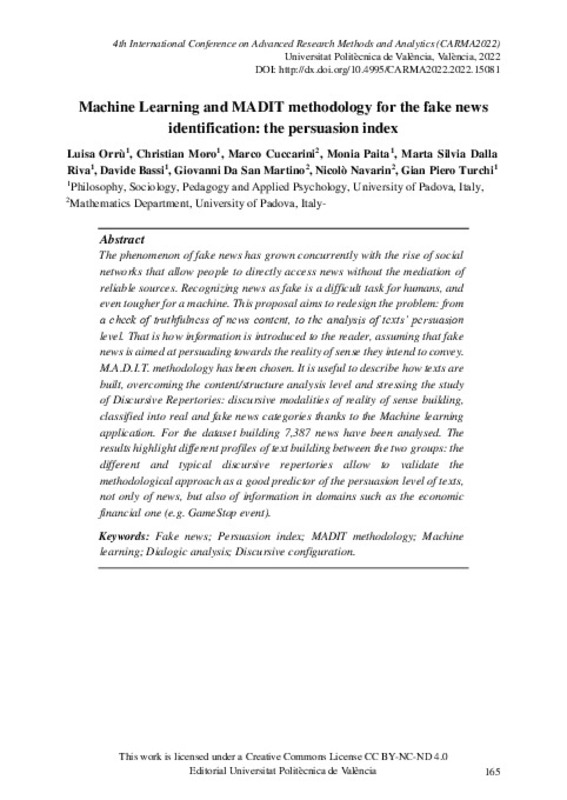JavaScript is disabled for your browser. Some features of this site may not work without it.
Buscar en RiuNet
Listar
Mi cuenta
Estadísticas
Ayuda RiuNet
Admin. UPV
Machine Learning and MADIT methodology for the fake news identification: the persuasion index
Mostrar el registro sencillo del ítem
Ficheros en el ítem
| dc.contributor.author | Orrù, Luisa
|
es_ES |
| dc.contributor.author | Moro, Christian
|
es_ES |
| dc.contributor.author | Cuccarini, Marco
|
es_ES |
| dc.contributor.author | Paita, Monia
|
es_ES |
| dc.contributor.author | Dalla Riva, Marta Silvia
|
es_ES |
| dc.contributor.author | Bassi, Davide
|
es_ES |
| dc.contributor.author | Da San Martino, Giovanni
|
es_ES |
| dc.contributor.author | Navarin, Nicolò
|
es_ES |
| dc.contributor.author | Turchi, Gian Piero
|
es_ES |
| dc.date.accessioned | 2022-11-08T10:42:57Z | |
| dc.date.available | 2022-11-08T10:42:57Z | |
| dc.date.issued | 2022-09-20 | |
| dc.identifier.isbn | 9788413960180 | |
| dc.identifier.uri | http://hdl.handle.net/10251/189453 | |
| dc.description.abstract | [EN] The phenomenon of fake news has grown concurrently with the rise of social networks that allow people to directly access news without the mediation of reliable sources. Recognizing news as fake is a difficult task for humans, and even tougher for a machine. This proposal aims to redesign the problem: from a check of truthfulness of news content, to the analysis of texts’ persuasion level. That is how information is introduced to the reader, assuming that fake news is aimed at persuading towards the reality of sense they intend to convey. M.A.D.I.T. methodology has been chosen. It is useful to describe how texts are built, overcoming the content/structure analysis level and stressing the study of Discursive Repertories: discursive modalities of reality of sense building, classified into real and fake news categories thanks to the Machine learning application. For the dataset building 7,387 news have been analysed. The results highlight different profiles of text building between the two groups: the different and typical discursive repertories allow to validate the methodological approach as a good predictor of the persuasion level of texts, not only of news, but also of information in domains such as the economic financial one (e.g. GameStop event). | es_ES |
| dc.format.extent | 8 | es_ES |
| dc.language | Inglés | es_ES |
| dc.publisher | Editorial Universitat Politècnica de València | es_ES |
| dc.relation.ispartof | 4th International Conference on Advanced Research Methods and Analytics (CARMA 2022) | |
| dc.rights | Reconocimiento - No comercial - Sin obra derivada (by-nc-nd) | es_ES |
| dc.subject | Fake news | es_ES |
| dc.subject | Persuasion index | es_ES |
| dc.subject | MADIT methodology | es_ES |
| dc.subject | Machine learning | es_ES |
| dc.subject | Dialogic analysis | es_ES |
| dc.subject | Discursive configuration | es_ES |
| dc.title | Machine Learning and MADIT methodology for the fake news identification: the persuasion index | es_ES |
| dc.type | Capítulo de libro | es_ES |
| dc.type | Comunicación en congreso | es_ES |
| dc.identifier.doi | 10.4995/CARMA2022.2022.15081 | |
| dc.rights.accessRights | Abierto | es_ES |
| dc.description.bibliographicCitation | Orrù, L.; Moro, C.; Cuccarini, M.; Paita, M.; Dalla Riva, MS.; Bassi, D.; Da San Martino, G.... (2022). Machine Learning and MADIT methodology for the fake news identification: the persuasion index. En 4th International Conference on Advanced Research Methods and Analytics (CARMA 2022). Editorial Universitat Politècnica de València. 165-172. https://doi.org/10.4995/CARMA2022.2022.15081 | es_ES |
| dc.description.accrualMethod | OCS | es_ES |
| dc.relation.conferencename | CARMA 2022 - 4th International Conference on Advanced Research Methods and Analytics | es_ES |
| dc.relation.conferencedate | Junio 29-Julio 01, 2022 | es_ES |
| dc.relation.conferenceplace | Valencia, España | |
| dc.relation.publisherversion | http://ocs.editorial.upv.es/index.php/CARMA/CARMA2022/paper/view/15081 | es_ES |
| dc.description.upvformatpinicio | 165 | es_ES |
| dc.description.upvformatpfin | 172 | es_ES |
| dc.type.version | info:eu-repo/semantics/publishedVersion | es_ES |
| dc.relation.pasarela | OCS\15081 | es_ES |








